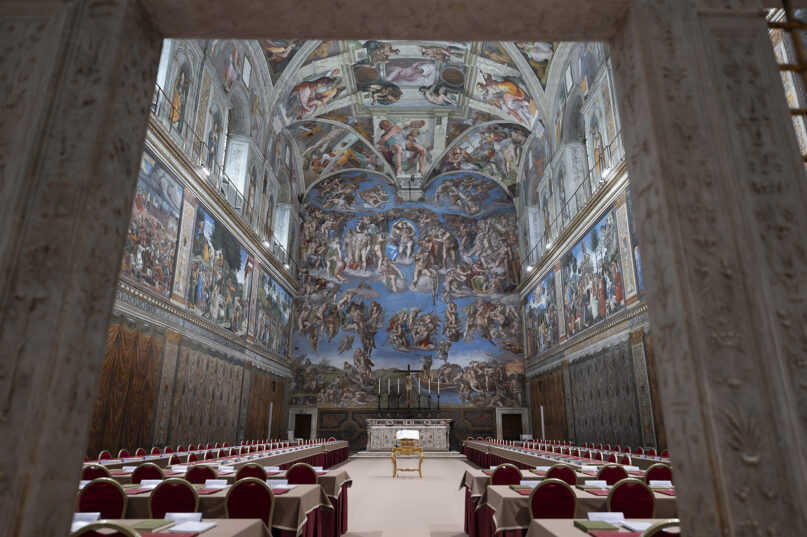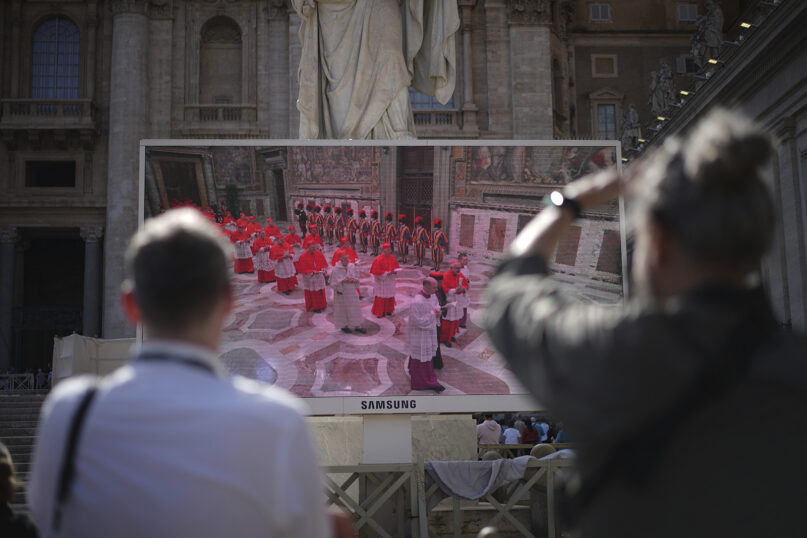VATICAN CITY (RNS) — Three conclaves set the stage for the moment when Pope Leo XIV stepped out onto the balcony of St. Peter’s Basilica, stunning the world as the first U.S.-born pontiff elected in just four ballots: the conclave depicted in the quiet Oscar-nominated movie; the conclave envisioned by the media frenzy; and the actual secret votes of a College of Cardinals who barely knew each other.
The first, the award-winning movie “Conclave” starring Ralph Fiennes and Stanley Tucci, portrayed a group of conniving cardinals vying for political power. Anyone on a long flight to Rome between Pope Francis’ death and the selection of his successor would have seen plenty of screens showing scarlet robes, skull caps and Michelangelo’s “Final Judgment” at the Sistine Chapel.
The second conclave was the one predicted by the media, which descended on the Eternal City eager for angles to satiate the curious public. Lists of “papabili,” or contenders to become pope, stories of intrigue and polarization, smear campaigns aimed at tarnishing the reputation of the cardinals — they all escalated the stakes, giving the watching world a scene to match the one on the silver screen.
Some cardinals admitted to watching the movie, as, having been appointed by Francis, they weren’t sure what to expect once they entered the conclave. But the six cardinal electors interviewed by RNS, some under the condition of anonymity, all insisted the election of Pope Leo XIV was poles apart from the versions depicted by Hollywood and predicted by the media.
“I imagined it would be different,” said Cardinal Jamie Spengler, archbishop of Porto Alegre in Brazil, who has been a cardinal only for six months and was unsure of what to expect from the conclave. Instead, he said, “we truly had a space of fraternity, faith, prayer and silence that you cannot imagine.”
For these conclave participants, the name of Cardinal Robert Prevost emerged as if “breathed from the Holy Spirit,” without kingmakers or campaigners.

But the cardinals agreed it was the Americas, North and South, who first backed the Chicago-born prelate, gaining momentum over the four votes as they offered a compromise candidate to the fragmented camps.
Pope Francis would often urge faithful to “make a mess,” or “parresia” in the ancient Greek term. Even in death, Francis was a disrupter within the institution, having radically transformed the College of Cardinals to lasting consequence.
He created the most geographically diverse crop of cardinals in the church’s history — handing red hats to places that have never had a cardinal before (such as Mongolia and South Sudan) — representing 71 nations on five continents. He also held fewer meetings of cardinals at the Vatican, meaning many of them were strangers when they met to elect his successor. Most cardinals had never participated in a conclave before, and their inexperience allowed them to walk into the secret gathering with a willingness — even a desire — to be awed.
Most of the cardinals told RNS they were profoundly moved by Francis’ funeral and the overwhelming display of love, affection and gratitude of the faithful who came from around the world. A cardinal’s job is to get people interested in Jesus Christ, one cardinal said, and the sight of people lining up for hours to pay their respects to Francis was an encouraging sign the church is still relevant today.

They walked into the conclave mindful of the responsibility to elect someone who could capture the attention brought by Francis’ death. In their minds, the words “feed my flock,” Jesus’ command to Simon Peter in the Gospel, echoed as a call to elect a pastor. The reading had been chosen by Pope Francis for his funeral, and they had reflected on it again when they said Mass in their titular churches in Rome ahead of the conclave.
The next time they would hear that reading would be at the ceremony inaugurating the start of Pope Leo XIV’s papacy.
Fame matters
As the cardinals gathered for general congregations before the conclave, there were few faces they immediately recognized. After the first day, they asked for name tags to identify one another, and they were handed a book from the Vatican with biographies of each one. When someone stepped forward to speak to the congregation, a large picture of them would appear on the screen behind them and the cardinals would quickly check to learn more about who was speaking.
Cardinal Pietro Parolin, the Vatican secretary of state under Francis, was an immediately recognizable name and face. So was Cardinal Angelo Becciu, whose name was at the center of a financial scandal that led to Francis stripping him of his cardinal rights, including participating in the conclave.
Cardinal Prevost also gave a speech at the general congregations, the cardinals confirmed, but they didn’t remember much of what he said. “It was the way he engaged in the smaller groups” that was impressive, one told RNS.
Plus, he was a familiar face to the cardinals, having served in an influential role at the helm of the Vatican department overseeing bishops.
“Many of us would have spoken to him at least one or two times” before the conclave, one cardinal said.
Cards on the table
When the doors of the Sistine Chapel were closed, following a 45-minute homily by Cardinal Raniero Cantalamessa, the cardinals cast their initial votes.
Parolin emerged with a substantial number of votes, between 40 and 50, but far from the 89 votes needed to achieve the two-thirds majority. Hungarian Cardinal Peter Erdo also had some support behind him, the cardinals told RNS, especially from conservative cardinals who appreciated his emphasis on doctrine, tradition and clarity.
Surprisingly, the more progressive prelates failed to build consensus behind a candidate. Maltese Cardinal Mario Grech, Filipino Cardinal Luis Antonio Tagle and even the up-and-coming Cardinal Pablo Virgilio David, also of the Philippines, could not muster a handful of votes.
But a sizable number of votes coalesced behind Prevost, leading many cardinals to take a second look. After the black smoke emerged at 9 p.m. on the first day of voting, the cardinals returned, exhausted, to Domus Sancta Marta to discuss names over a warm meal.
They sat at tables mostly according to language groups, the cardinals said, but they overheard the English “good night” more often than the Italian “Buona notte” or the Spanish “Buenas noches.”

The Americas united
It became clear Prevost, who served for more than two decades in Peru before coming to the Vatican, had garnered support among the 21 Latin American cardinals, representing 18% of the votes. But there were also U.S. cardinals who knew him and promoted him early on. Cardinal Joseph W. Tobin of Newark had a longstanding relationship with “Bob” for decades and, in the days leading up to the conclave, told journalists he believed Prevost had a good chance of becoming pope.
Some of the more conservative U.S. cardinals had put their weight behind Erdo in the first vote but were quick to shift gears once it became clear Prevost was gaining momentum. There were 16 cardinals from North America at the conclave, 10 from the U.S. and six from Canada, and most ultimately rallied behind the cardinal from the Americas.
The support behind Parolin was fragmented and easily swayed, according to the participants who spoke with RNS. Some cardinals opposed Parolin’s leadership role in signing a controversial agreement with China on the appointment of bishops, while others were critical of his handling of financial scandals in the Vatican. But most of all, the experienced diplomat and Vatican bureaucrat lacked what the faithful had so strongly asked for in the wake of Francis’ death: a pope who could also be a pastor.
As one keen Vatican observer said, “sometimes a great No. 2, doesn’t necessarily make a great No. 1.” And so the votes for Parolin, mostly curial members and Catholic moderates, began to shift toward Prevost.
Emerging consensus
Prevost had plenty of pastoral experience. Between 1985 and 1998 he was a missionary in Peru serving the poor and Indigenous communities there. In 2015, Francis made him Bishop of the Diocese of Chiclayo in the Northwestern region of Peru.

And he had proven management skills as the head of the Augustinian Order between 2001 and 2013 and as head of the Vatican’s department overseeing bishops. He had also visited 47 countries where the Augustinian Order was present, giving him insight into the reality of the church on the ground around the world. Cardinals appreciated his leadership method, quiet and listening yet decisive.
Conservative cardinals found comfort in his background as a mathematician, theologian and canon lawyer, while more progressive cardinals looked hopefully at his interest in social justice issues. “He seemed to check all the boxes,” said Cardinal Blase Cupich of Chicago in an interview with NPR.
“His name just emerged, there was no effort on his part or anyone else’s to promote this. But as we looked at all the qualities that we identified, he seemed to make a good fit,” he added.
The only tick against him was being born in the United States, which in the past would have automatically excluded a cardinal from being a candidate for the papacy to avoid combining the church’s spiritual authority with the political influence of a global superpower.
But next to the other U.S. cardinals, with their larger-than-life charisma and stature to match, Prevost was small and shy. Cupich said Prevost “identified very much as Peruvian,” where he became a naturalized citizen in 2015.

As cardinals rallied behind Prevost, including a number from Asia and Africa, they recognized in him someone who could straddle both worlds, the developing and the developed. He could speak with authority to the existential demands of the Western world, grappling with technological revolutions and identity wars, while also recognizing the priorities of countries ravaged by famine, poverty, war and climate change.
A new pope
When Pope Leo XIV was elected with more than 100 votes, applause erupted from the cardinals in the conclave. After so many years of the media presenting the church as divided, the cardinals had achieved a peaceful transition of power in just four ballots over two days.

The new pope was not just deft at overcoming geographical divides, but he also offered the right compromise for differing views on the future of the church. Both progressive and conservative cardinals told RNS that with the election of Leo they had “dodged a bullet,” suggesting a concern the conclave could have tipped to one extreme or the other.
“We have someone who knows us and is aware of our challenges, knows our possibilities and potential,” Spengler said. “I think the church can advance under him in communion and unity.”
In his first week as pope, Leo XIV made efforts to encompass different factions of the church, and in his homily for the Mass that inaugurated his ministry as pope on Sunday (May 18), he made an appeal for unity:
“In this spirit of faith, the College of Cardinals met for the conclave. Coming from different backgrounds and experiences, we placed in God’s hands our desire to elect the new Successor of Peter, the Bishop of Rome, a shepherd capable of preserving the rich heritage of the Christian faith and, at the same time, looking to the future, in order to confront the questions, concerns and challenges of today’s world. Accompanied by your prayers, we could feel the working of the Holy Spirit, who was able to bring us into harmony, like musical instruments, so that our heartstrings could vibrate in a single melody.”
Original Source: